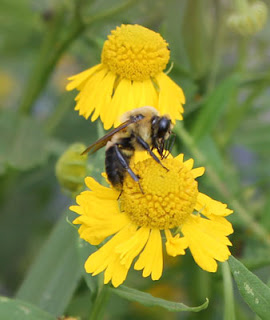When I consider the idyllic romance that now surrounds the
Farm to Table movement, I’m not sure whether to laugh or roll my eyes. Maybe
both. In real life, at least this time of year, it is a frantic race against
spoilage. Sometimes, as with corn, it involves marathons of blanching, freezing
and/or canning. For foods that are not easily preserved, it means gorging on
whatever is ripe to the point of not being able to look at it until next year. I
considered it a victory when we finished the last of a giant bag of lettuce
before it rotted (much). Every night when I make dinner, I contemplate how many
vegetables I can serve before Terry revolts. The answer is generally one, but
he will eat cucumbers in sour cream with BLTs. (I have had people ask for my
recipe for cucumbers in sour cream. Here it is: Peel, deseed if necessary, and
slice cucumbers; add sour cream and stir.)
The cantaloupe began to ripen about 10 days ago. Terry
estimated there were 50 melons out there. It was fine at first, a melon here
and a melon there. We could keep up. I fear that there will be a day when we
have 40 ripe cantaloupe all at once. It’s already starting. In the last two
days, I have harvested 12 cantaloupe. What do you do with 12 cantaloupe? We got
rid of two when my brother, SIL, and their friend came to visit Saturday. Hilda
took one. I can eat one cantaloupe in four days. When I brought the harvest in Sunday,
I asked Hilda if she was ready for another melon.
“We still have some from yesterday,” she said.
“Eat faster!” I replied.
I will have to take some to work, and certainly my friends
will be glad to get them. There is nothing like a vine-ripened melon. They are,
however, bulky, heavy, and generally a pain to be hauling around. It will be a
good work out.
 |
| Nine cantaloupe in the refrigerator |
Terry called the house one morning when I was home to tell
me that the five tom turkeys had met up with some hens and adolescents from
this year and were walking around on the north side of the farm. I got my
camera and went out to have a look. I walked slowly toward them and they walked
away from me at exactly the same rate. I could only tell which ones were chicks
when they were next to the adults.
 |
| The turkey chicks are only a little smaller than the adults |
It’s good to know that some of them survived and are big
enough to make it through the winter. As
best I could tell there were four chicks. Their heads seem to be blue.
 |
| Four chicks together. Their heads look blue. |
In this photo, the chicks are on the left, and the toms are
on the right. The toms are showing off their red snoods and waddles.
 |
| The toms (right) show off their snoods and wattles (in red) |
The wild cucumbers are going crazy. They are native plants
and seem quite aggressive. I don’t remember noticing them before I moved here. Now
I see them everywhere. I suppose they have been growing all summer long, but
when they send up their white spikes of flowers, they are much more visible,
carpeting the trees and shrubs underneath. Unlike domestic cucumbers, the
fruits have spines. They also have a fibrous interior which will persist well
into next summer, looking like a small loofa. Wild cucumbers are one of summer’s
last hurrahs. Autumn is definitely on the way. How sad.
 |
| Wild cucumbers signals the end of summer |





























